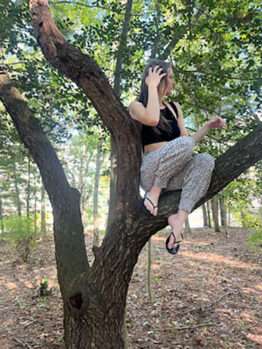Black Cherry
Researched by Rachel Ray
 Species: Prunus serotina
Species: Prunus serotina
Common name: Black Cherry Tree
Family: Rosaceae (Rose Family)
Clade: Angiosperms (flowering seed plants)
Coordinates: 39.71180301, -75.12312836
A tag using this number is placed near the tree.
Prunus serotina, the black cherry tree, is native to the eastern United States and can grow between 1.5 and 2.5 feet per year, reaching heights of up to 80 feet. As the tree ages, branches begin to arch, making them weaker and more prone to damage, but the species can live for more than 250 years.
Despite its common name, Prunus serotina is not closely related to other cherry species like the sweet cherry, sour cherry, and Japanese flowering cherry. It stands apart from these species due to its racemose inflorescences or unbranched and clustered flower arrangement.
Its flowers are hermaphroditic, meaning they have male (stamens) and female (pistils) reproductive organs, enabling the tree to pollinate itself for reproduction. Black cherry trees produce clusters of dense, white pyramidal flowers between April and May. After pollination, flowers mature into dark reddish-purple fruits called drupes, where the name “black cherry” comes from. The fruits feed birds and bears, who aid in dispersing the seeds. Read More
Campus Species Map
Researcher’s Biography
 Rachel Ray
Rachel Ray
Rachel Ray graduated with a degree in biological sciences in 2022.
Suggested Citation:
Last, First. (2022, Dec). Black Cherry. Rowan University Arboretum. https://arboretum.rowan.edu/trees/black-cherry/
Questions to Explore
- How were black cherry trees used by Native Americans?
- How do black cherry trees impact the environment?
- What threats do black cherry trees face, and why?
- How were black cherry trees used in Colonial South Jersey?
- How does the black cherry tree change as it ages
References
Black cherry. Missouri Department of Conservation. (n.d.). | Link
Larcenaire, Wang, F., Holásková, I., Turcotte, R., Gutensohn, M., & Park, Y.-L. (2021). Characterization of the Insect Assemblage and Associated Floral Volatiles of Black Cherry (Prunus serotina). Plants (Basel), 10(10), 2195–. | Link
Marquis, D. A. (n.d.). Black Cherry. Prunus serotina Ehrh. | Link
Pairon, Chabrerie, O., Casado, C. M., & Jacquemart, A.-L. (2006). Sexual regeneration traits linked to black cherry ( Prunus serotina Ehrh.) invasiveness. Acta Oecologica (Montrouge), 30(2), 238–247. | Link
Pairon, Petitpierre, B., Campbell, M., Guisan, A., Broennimann, O., Baret, P. V., Jacquemart, A.-L., & Besnard, G. (2010). Multiple introductions boosted genetic diversity in the invasive range of black cherry (Prunus serotina; Rosaceae). Annals of Botany, 105(6), 881–890. | Link
Prunus serotina. Prunus serotina (Black Cherry, Wild Cherry, Wild Rum Cherry) | North Carolina Extension Gardener Plant Toolbox. (n.d.). | Link.
Rowan University Resources
You may need to log into the Rowan University Library website.
Modeling seed dispersal of black cherry, an invasive forest tree: how microsatellites may help | Link
Light environment alters ozone uptake per net photosythetic rate in black cherry trees | Link
Physiology, morphology, and ozone uptake of leaves of black cherry seedlings, saplings, and canopy trees | Link



















